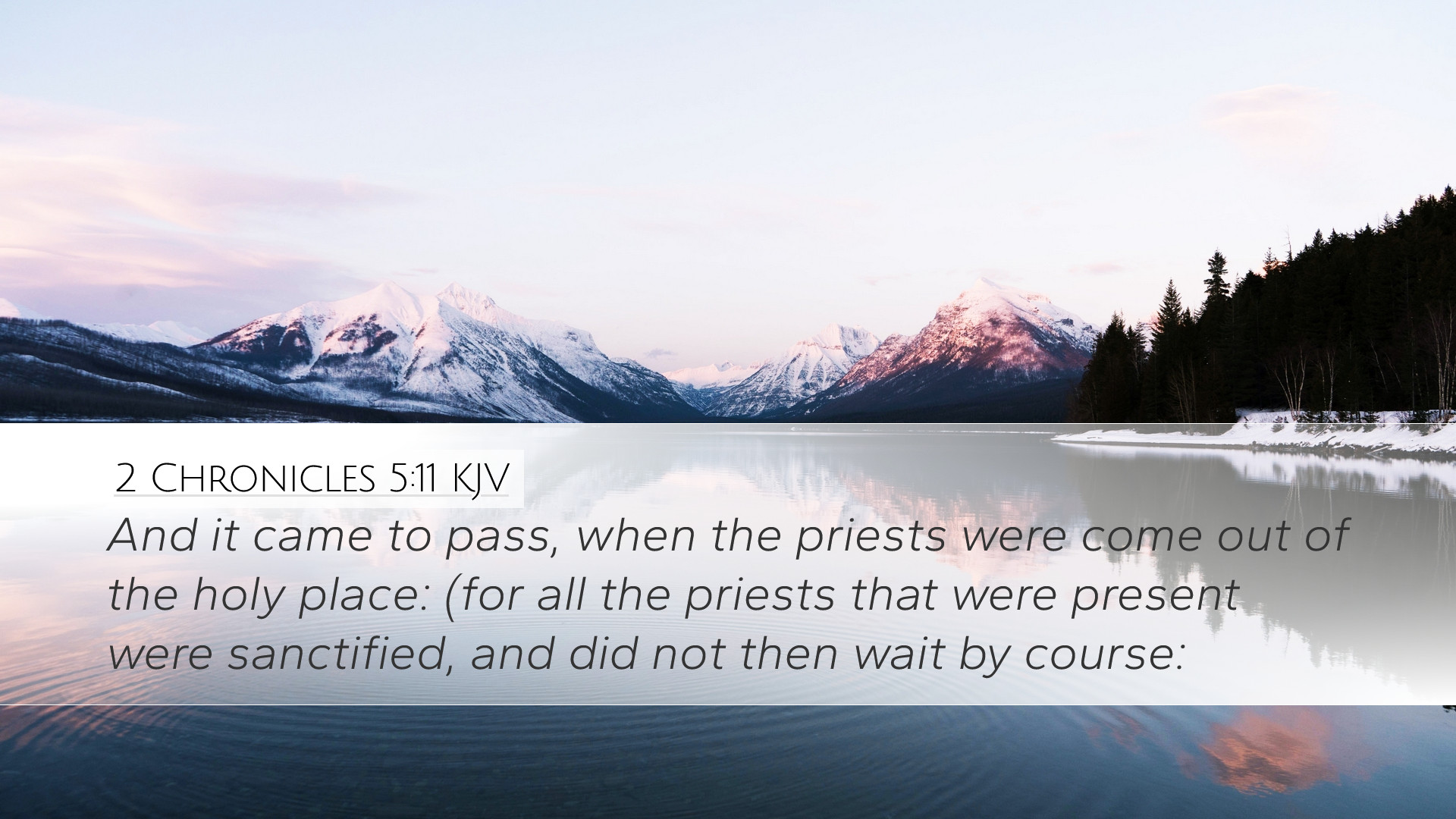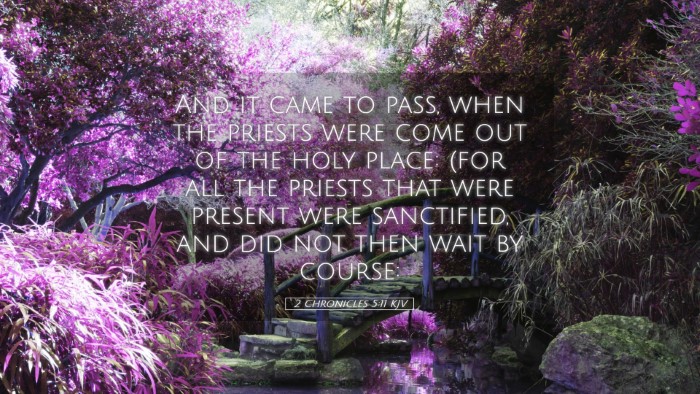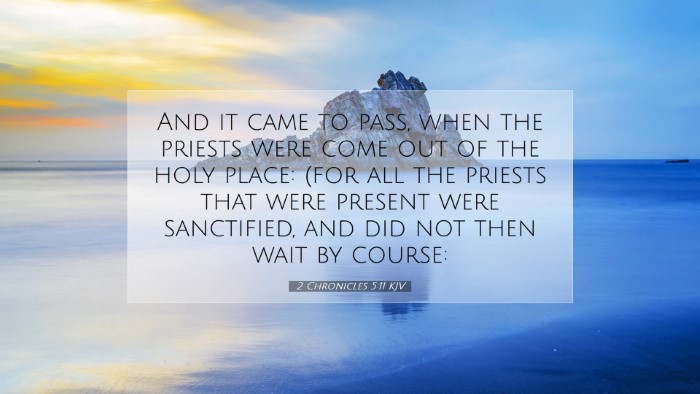Commentary on 2 Chronicles 5:11
Bible Verse: 2 Chronicles 5:11 - "And it came to pass, when the priests were come out of the holy place: for all the priests that were present were sanctified, and did not then wait by course."
Introduction
This significant verse captures a key moment in the dedication of the temple and the ministry of worship in ancient Israel. It speaks volumes about the sanctification of the priests and their essential role in leading the people in worship. Commentators such as Matthew Henry, Albert Barnes, and Adam Clarke provide valuable insights into the themes of holiness, unity in worship, and the fulfillment of God's promises.
Contextual Analysis
The preceding chapters of 2 Chronicles detail Solomon's construction of the temple and the preparations made for its dedication. This verse specifically highlights the moment when the priests exit the holy place after having performed their duties. The significance lies in their sanctification, which signifies readiness to serve the Lord and lead the people in worship.
Significance of the Priests' Sanctification
Matthew Henry emphasizes that the sanctification of the priests was a prerequisite for their ministry, illustrating that God requires holiness from those who serve Him. This notion aligns with the broader biblical principle that holiness is not merely an outward manifestation but a spiritual state that affects every aspect of worship. The priests are a representation of the people before God, and their sanctified state assures the congregation of God's presence among them.
The Unity of the Priests
Albert Barnes notes the phrase "all the priests were present" as a significant indication of unity in worship. They did not wait by course but were collectively engaged in their sanctified duties. This unity among the priests served as a powerful witness to the people of Israel. Such collective participation reflects the nature of the church today, where unity in the body of Christ is essential for effective worship and service.
The Role of Worship
In this verse, the act of worship is underscored as a communal experience rather than an individual one. Adam Clarke points out that the involvement of all the priests highlights the importance of collective worship. When the priests are united, it generates an atmosphere conducive to experiencing God’s presence, leading to an outpouring of worship from the entire congregation.
Corporate Worship vs. Individual Worship
This discussion invites further contemplation on the dynamics of corporate versus individual worship. Matthew Henry teaches that while personal devotion is fundamental, corporate worship brings believers together in a way that emphasizes collective faith and communal identity. It is in this unified assembly that God's glory is most palpably felt.
Theological Implications
This single verse encapsulates profound theological truths relevant to pastoral ministry and theological study. It brings forward the understanding that God's presence is intimately connected with holiness and worship. The act of coming out from the holy place symbolizes a transformative experience—the priests, having undergone sanctification, are now equipped to engage the congregation in worship.
Holiness and Ministry
Albert Barnes discusses how the qualifications for ministry begin with holiness. The expectations placed upon the priests serve as an exhortation for contemporary leaders within the church. Leaders must be set apart, displaying integrity and sanctity in their lives to effectively guide their congregations in worship and spiritual matters.
Sacred Space and God's Presence
Adam Clarke elaborates on the concept of "holy place" and the significance it carries. The temple was not just a physical structure; it was a delineation of where God’s presence dwelled among His people. The priests' emerging from this sacred space represents the intercessory role they play, bridging the gap between a holy God and a sinful people.
Practical Applications for Today
As pastors, students, and theologians reflect on this verse, it is pertinent to consider practical applications relevant for today’s church.
- Emphasize the Necessity of Holiness: Church leaders should focus on fostering an environment where holiness is prioritized, encouraging both leaders and congregants to pursue a deeper relationship with God.
- Foster Unity in Worship: Promote opportunities for congregational participation, ensuring that worship is seen as a collective experience rather than isolated acts. This entails involving the congregation in various aspects of worship services.
- Teach the Importance of Sacred Spaces: Help congregants recognize the significance of their worship spaces as places where God’s presence can be experienced. Encourage reverence within these spaces.
- Equip Leaders for Effective Ministry: Invest time in the sanctification and spiritual growth of church leaders, recognizing that their relationship with God directly impacts their ability to lead others in worship.
Conclusion
2 Chronicles 5:11 provides profound insights into the spiritual posture necessary for worship. The sanctification of the priests and their unity offers a model for contemporary worship practices. As leaders, scholars, and faithful followers of Christ engage with this verse, they are reminded of the importance of holiness, unity, and the divine presence in worship. By adhering to these timeless principles, the church can continue to grow in faith and glorify God in all that it does.


